|
|
JAMES BOND
|
|
|
JAMES BOND
|
|
||||
|
||||
|
Although not part of the official EON Productions series, Casino Royale also had a film tie-in edition published in paperback by PAN Books in 1966. The spoof film version of Ian Fleming's first novel premiered in London in April of 1967, and sales of CASINO ROYALE had increased significantly by the end of the year. Although issued whilst the Raymond Hawkey cover edition was still in circulation, the film tie-in featured the title CASINO ROYALE in large letters above the authors name in the same style as the Hawkey cover. Utilising Robert McGinnis's poster artwork which wrapped around to the back cover, the tie-in did not use stills from the film, instead PAN printed the cast and credits on the rear, thus separating it from the other film tie-ins issued in paperback. The US film-tie-in published by Signet Books used a repainted version of the McGinnis art. The artist himself later repainted his own version which was used on the cover of the 2008 Collector's edition DVD and 2011 Blu-ray of the film, inexplicably including Christopher Lee’s Scaramanga, Roger Moore in Live And Let Die and Sandor (Milton Reid) from The Spy Who Loved Me. The original signed 23.5 X 30.5 inch artwork was sold for $47,500 by Heritage Auctions in October 2017. |
||||
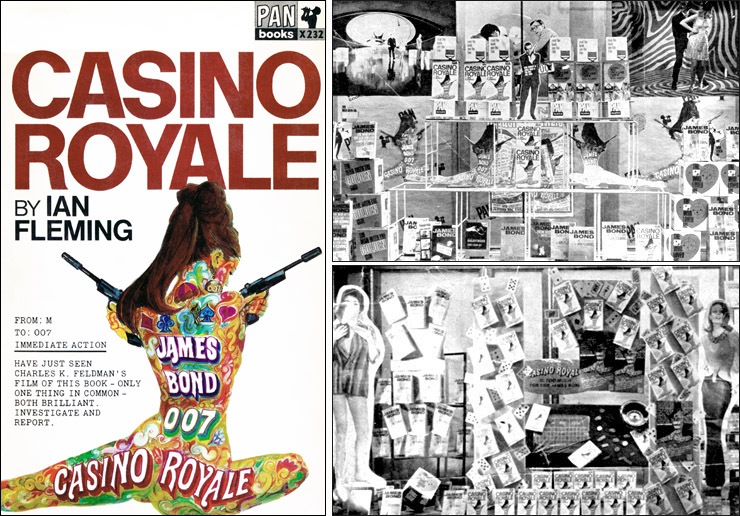 |
||||
|
Over the weekend of 15th and 16th April 1967, six tattooed body-stocking-clad models were driven around central London in a Ford Mustang convertible, taking part in a promotional drive and giving away film posters and copies of the PAN paperback tie-in of CASINO ROYALE. Interest in Ian Fleming's first novel was obviously high during the release of the film and sales had rocketed to 177,000 for this title by the end of 1967. To highlight the fact that the release of each film boosted sales of that novel, the number of copies sold in Britain in 1968 – a year no new Bond film was released – was just 9,000 – the lowest ever up to that point. |
||||
 |
||||
|
PAN Books ran a new James Bond window display competition to coincide with the publication of the CASINO ROYALE film tie-in paperback, YOU ONLY LIVE TWICE film tie-in, THE MAN WITH THE GOLDEN GUN and THE SPY WHO LOVED ME which both made their UK paperback debut on May 12, 1967. By that Casino Royale was part-way through its planned general release pattern of two weeks at each cinema on the ODEON first-run circuit in the UK, although many locations cancelled the second week when the film proved less popular in the provinces than in London's West End. |
||||
|
||||
|
As there were two James Bond films released in 1967, the CASINO ROYALE film tie-in was displayed alongside YOU ONLY LIVE TWICE in many shops and sales of each was almost identical by the end of the year, with both paperbacks selling around 177,000 copies. Although YOU ONLY LIVE TWICE had been published in paperback in 1965 with the Raymond Hawkey cover, the 1st edition was an export only version with the 2nd edition not available in the UK until May 1966. PAN Books cleverly sold off remaining stock of the Hawkey 1st edition inside a wrap-around dust jacket of the film tie-in cover. Copies of this edition are exceptionally rare and very hard to find as the majority were exported as part of the initial 250,000 print-run in July 1965. |
||||
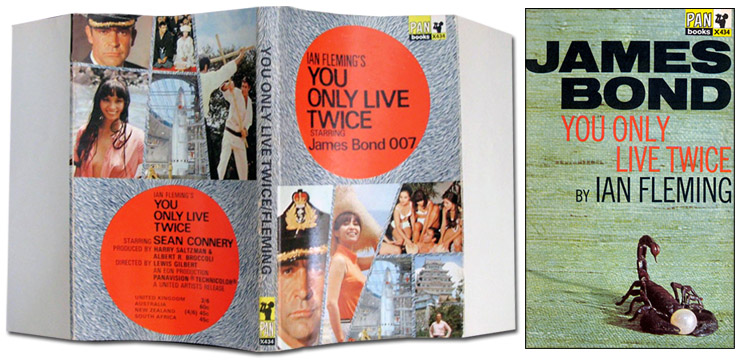 |
||||
|
The United Artists Exhibitors’ Campaign Book that accompanied the release of You Only Live Twice showed several promotional items produced by PAN Books for use in window displays. Once again, a competition ran from the film's premiere in London on June 12, 1967, until the end of the year. The Campaign Book included a mock-up window display showing how the cut-out showcards could be utilised. The mock-up display also included card cubes used to promote the release of THE SPY WHO LOVED ME, which had been first published in paperback by PAN Books in May 1967. The campaign book showed an Atlas Missile showcard (21.5" high X 9.75" wide), a James Bond cut-out (13.5" high X 6.75" wide), and a James Bond book tuck-in (7.75" high X 7.5" wide including book). The Sean Connery image was actually a publicity still by David Hurn and part of a series of photographs used in the From Russia With Love advertising campaign in 1963. |
||||
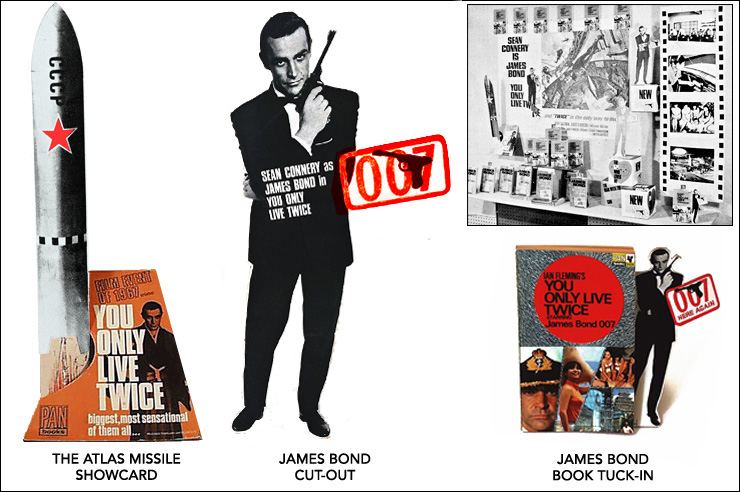 |
||||
|
This time the contest awarded prizes for the best 75 window displays in two sections; the first for the 25 best big window displays (open to stores, larger bookshops and branches of W. H. Smith, Boots, Rymans, John Menzies etc.) with prizes of Fantavox 8-transistor radios to the book buyer and window dresser in each case, and the second section for the best 25 small windows, with 50 Fantavox 8-transistor radios awarded to the manager or his window dresser. The W. H. Smith store in Great Yarmouth [pictured below left] was one of the winning entries with a PAN Books tie-in that was boosted by a visit to the East coast seaside resort by Wing-Commander Ken Wallis, who put on an aerobatic display with his autogyro ‘Little Nellie’, which remained on display in the town for a week during the release of You Only Live Twice. |
||||
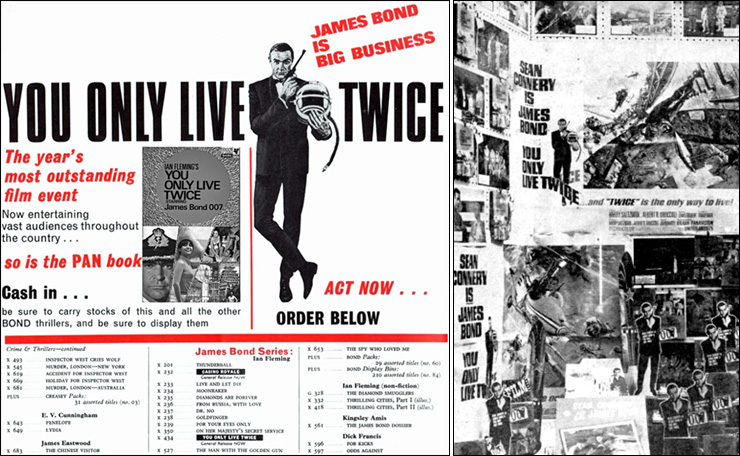 |
||||
|
PAN Books provided a range of display material for the promotion of the ON HER MAJESTY'S SECRET SERVICE film tie-in in 1969. The United Artists Exhibitors’ Campaign Book illustrated a cardboard counter display stand and free-standing book display, together with a colour poster. PAN also produced a vertical banner (29" X 9½") for use in bookshop displays. |
||||
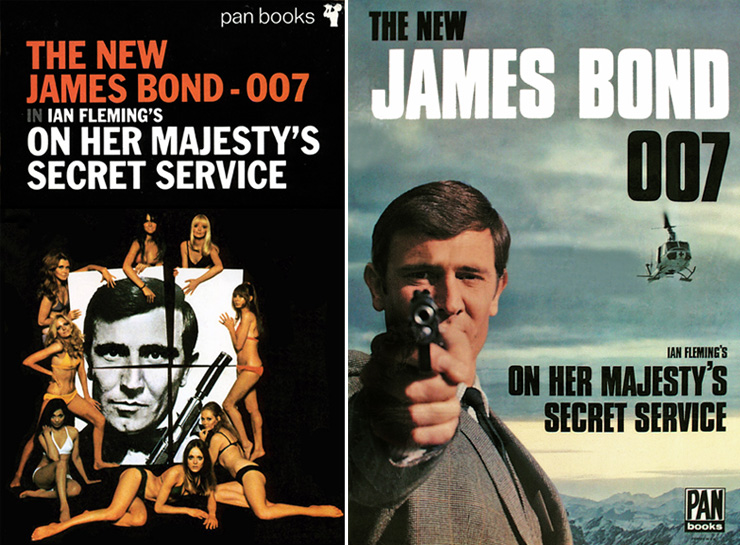 |
||||
|
The PAN paperback cover emphasised the fact there was a new James Bond 007 and featured the same photo of bikini-clad models on the front and back cover. A series of black & white stills from the film appear on the inside-front and inside-back covers. One of the models on the cover is Jenny Hanley [bottom right] (who appears in the film as the Irish Girl); and the model at the top left is Caroline Munro who would later appear in The Spy Who Loved Me (1977) as Naomi. The US Signet paperback used an alternate image from the same photo-shoot, but the US advance 1-sheet poster features an entirely different set of models from an American photo session. However, Jenny Hanley and other models were composited into the final image, so Hanley appears on the cover of the UK and US paperback and on the US poster, although she was only present at the UK photo-shoot. The composite image was also used on the Australian posters for the film. Read more about the two OHMSS photo-shoots! |
||||
|
|
||||
|
Curiously it would appear that all three printings of the ON HER MAJESTY'S SECRET SERVICE film tie-in were bound using leftover sets of pages from the 4th, 5th and 6th printings in 1965. The PAN marketing materials issued prior to the October 10th publication even state that although the book has a new cover it was a re-bind. This explains why all copies of the OHMSS tie-in then in circulation in the UK had a first page indicating against the title GOLDFINGER that "EON films have now made the third film, starring Sean Connery as Bond, from this title". Although the film tie-in was released at the same time as the ‘white-model’ series of PAN paperbacks were in circulation, there was no version of ON HER MAJESTY'S SECRET SERVICE published with that style cover; but the inside front page of some of the ‘white-model’ titles did correctly state that “EON films are now making the sixth film, starring George Lazenby as Bond, from this title”. Despite this anomaly, ON HER MAJESTY'S SECRET SERVICE was unsurprisingly the most popular James Bond paperback in 1969 selling 117,000 copies, which was over twice as many as its nearest rival THE MAN WITH THE GOLDEN GUN, which achieved sales of 48,000 in the UK. |
||||
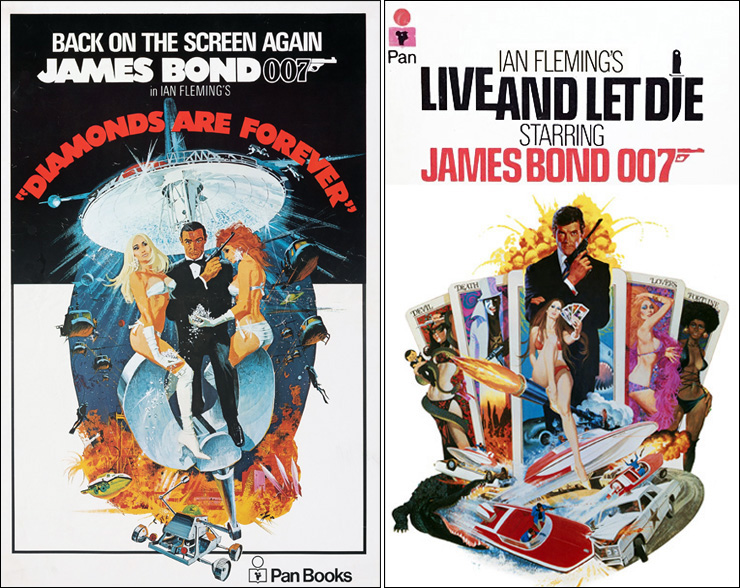 |
||||
|
Sean Connery's return to the role of James Bond in 1971 was supported by the release of a film tie-in edition of DIAMONDS ARE FOREVER with a cover featuring concept artwork by Robert McGinnis, arguably superior to the final art seen on the film posters. Unfortunately the paperback cover version cropped the iconic Moon Buggy at the bottom of the image, but the news-stand poster [pictured above left] showed the complete artwork. The back cover featured a still of Sean Connery in Las Vegas, which is a composite from a quickly snapped shot taken of the actor on the Pinewood backlot, and that image overlaid on an existing photograph of Connery taken on the Vegas strip during filming [inset below]. The same image appeared on the brochure (front & back cover) produced for the Gala Scottish Premiere of Diamonds Are Forever (held at the ODEON Cinema, Clerk Street, Edinburgh on January 14, 1972), which was the only premiere for the film, and the only one attended by the star. To help promote the film and tie-in PAN Books produced thousands of four-colour posters (20" X 12") which were sent to booksellers for windows and/or in-store displays. The film tie-in sold very well and was reprinted twice more in 1972, selling 150,000 copies by the end of the year. |
||||
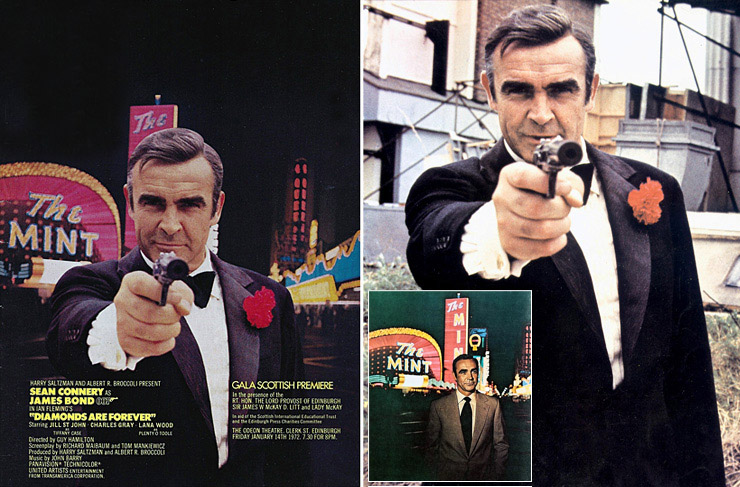 |
||||
|
By contrast, sales of LIVE AND LET DIE were never very high in the UK (apart from during the 1963-1966 ‘Bondmania’ years) and the remaining stock of the ‘white-model’ edition sold out in 1971 which was the only printing with that cover. The paperback was therefore out-of-print in 1972, but the announcement that EON Productions were to film LIVE AND LET DIE as Roger Moore's debut as James Bond in 1973 triggered the release of a new edition. Featuring the superb Robert McGinnis poster art on the cover and a film still on the rear, the film tie-in edition sold an incredible 240,000 copies in 1973. |
||||
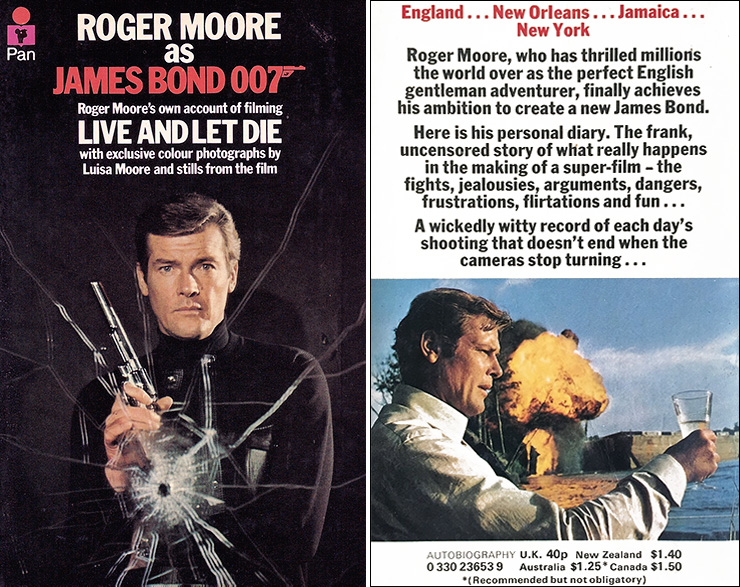 |
||||
|
The release of the film tie-in edition boosted sales of other titles to around half-a-million copies in the UK that year, the highest since 1968 when the first paperback edition of OCTOPUSSY had accounted for half the annual number of 659,000 sold. The LIVE AND LET DIE film tie-in was in circulation at the same time as the PAN ‘still-life’ covers which explains its absence from that series, although it is possible that a cover was photographed and never used as it is the only title missing. This was around the time this writer started reading and collecting the paperbacks. With no frame of reference as to what was available, I looked in vain for years for a ‘still-life’ edition of LIVE AND LET DIE! In July 1973 PAN Books also published Roger Moore's own account of the filming of Live And Let Die in paperback (with eight pages of colour photos from the film). This book also increased awareness in Ian Fleming's novels and LIVE AND LET DIE eventually achieved total sales of 2.5-million copies since its debut in paperback in 1957. By 1977 it was the third most popular title after GOLDFINGER and THUNDERBALL which sold in huge numbers in the mid-1960s, aided by the release of the two film adaptations at the peak of ‘Bondmania’. |
||||
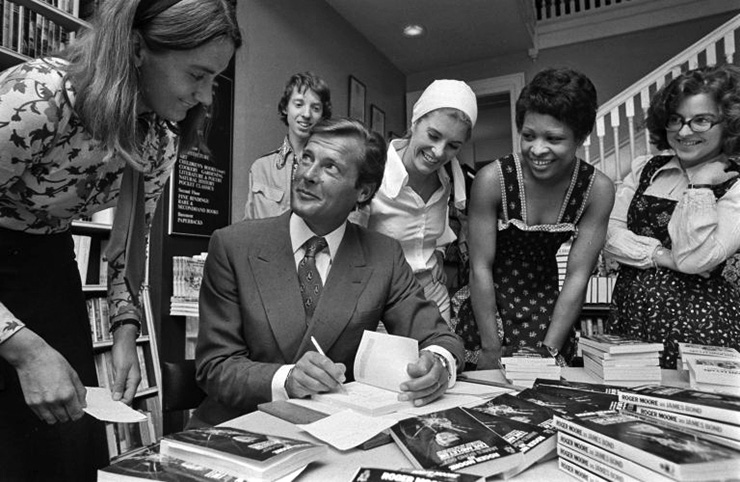 |
||||
|
Although credited to Roger Moore, his account of the filming of Live And Let Die was actually ghost-written by EON Productions publicist Derek Coyte from Moore's audiotape dictation notes. Roger Moore was honoured with a Foyle's Literary Luncheon in July 1973 - the first ever held to celebrate a paperback title. Initiated in 1930, the famous literary lunches were the brainchild of Christina Foyle (1911-1999), the daughter of bookstore co-founder William Foyle (1885–1963). Usually taking place at The Dorchester or Grosvenor House hotel in London's Mayfair, with guest speakers as well as the author in attendance, the lunches brought together notable writers and other distinguished figures to meet members of the public. From 1956-1966 Foyle's had also published affordable hardback editions of Ian Fleming's James novels under their various Book Club imprints. Roger Moore signed copies of his book [pictured above] at Hatchards bookstore in Piccadilly on July 11, 1973 - a week after the London premiere of Live And Let Die at the ODEON Leicester Square. The book was also published in paperback by Fawcett Gold Medal in New York in 1973 under the title Roger Moore's James Bond Diary. Out-of-print for over 40 years, a limited hardcover edition was then published in the UK by The History Press on June 1, 2018, with a new introduction by Moore's friend and co-star David Hedison (1927-2019) [Felix Leiter in Live And Let Die (1973) and Licence To Kill (1989)], this time the book was titled The 007 Diaries: Filming Live And Let Die. |
||||
|
The PAN Books film tie-in of THE MAN WITH THE GOLDEN GUN once again gave a much-needed boost in sales to the James Bond paperbacks, which had dropped to just 223,000 copies sold in the UK in 1974, the lowest annual sales since 1958. With Roger Moore's second outing as 007 playing across the country in early 1975, sales of the paperbacks increased to a respectable 365,000 across all titles in that year, with the film tie-in edition accounting for 131,000 of that total. The film tie-in was reprinted in May 1976 although by this time sales were just 11,000 copies. The 1974 printing included the film credits on the inside-front cover but these were missing from the 1976 reprint, which by this time had now been re-priced to 60p. |
||||
|
||||
|
||||
|
By the end of 1977 when PAN ceased publishing the James Bond paperbacks they had sold a staggering total of 27,863,500 copies in Great Britain, and the film tie-ins were responsible for a large proportion of those sales, also creating renewed interest in Ian Fleming's other novels as each new film was released. From 1978 other publishers took over the James Bond back catalogue, although sales were never as high as when the novels were first released at the height of ‘Bondmania’ in the mid-1960s. |
||||
|
||||